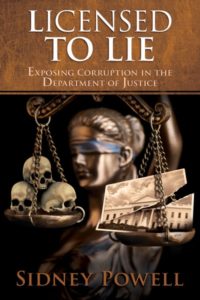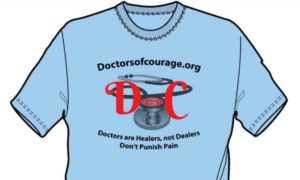
by Sidney Powell
Chapter 5: Nailing the Coffins
The judge made the following errors:
- At the prosecutors’ request, he expanded the already broad definition of conspiracy (which requires an “agreement”) beyond all prior boundaries by adding “or understanding.”
- He did not give the requisite instructions as to the elements that create criminal intent: “knowingly” and “willfully”.
- He refused to give an instruction that the defendants were acting in good faith in relying on their counsel.
- He refused to give an instruction that would explain the best-efforts or remarketing agreement as the theory of the defense.
With the criminal intent element missing, the prosecutors maintained that they only needed to show that these defendants intend to accomplish an objective. They do not have to show that the objective is illegal. This new definition of “conspiracy” alone had no basis in law. If something is not illegal, it is not a crime to do it. But that was a minor detail to the prosecutors or the judge. Judge Werlein gave the jury instructions that effectively guaranteed a conviction. The word “understanding” by any defendant was now criminal.
Jim Brown was also charged with perjury and obstruction of justice based on his answers to three questions in the Enron Grand Jury. Weissmann had instructed him to share whatever his “personal understanding” was—whether it was accurate or not. Then they indicted him for testifying that his personal understanding was “inconsistent with” Enron’s belief that it was obligated to get Merrill out of the deal. Brown was not on the telephone call, but the prosecution, using an email written more than a year later in an entirely different context, was able to exclude defense evidence that provided the context, and excluded hundreds of pages of Brown’s testimony to the SEC, grand jury, and bankruptcy examiner.
This was extreme unjust manipulation of the legal system to convict an innocent man. To what end? Justice? Of course not. Because they could? Obviously. It is just this abuse of power that the American people have to recognize and swing the pendulum away from believing what prosecutors present and believe more that what they present is slanted illegally toward conviction. As our forefathers stated, the law is supposed to be so strict that it ensures the innocent are not convicted, even to the point that some guilty go free. It is not to be so slanted that the innocent are convicted. But that appears to be more the case today. The prosecutors in this case and cases following must make us believe more in the philosophy of:
Fool me once, shame on you. Fool me twice, shame on me.
Then, as a final act of power, upon Jim Brown’s conviction, Weissmann and his task force pressured Merrill Lynch to stop paying the legal fees for the defense of the executives. The task force even put a supervisor in at Merrill to review all attorney bills, so they knew exactly what they were doing.
This chapter exposes the court system for what it is today—a legal railroading job. A Goliath out of control. In the case of doctors being attacked, the government goes after the low-hanging fruit—doctors that are solo practice, scraping by so that they can’t afford expensive lawyers. That makes them easy kills. Add that fact to the fact that judges work to the favor of the prosecution, and doctors don’t have a chance—that is—until the American people are educated as to the evil being done in the courtroom, and juries stop falling for these illegal actions.
Chapter 6: Facing the Firing Squad
Jim Brown and his family were now faced with potential life in prison (30-35 years) as an innocent man. This is a really hard pill to swallow. I know, because I was there too. Thoughts of fleeing the country or even suicide went through his mind. But, being innocent, he knew that either of those would point to his being guilty, and he couldn’t give in to that. He had to fight. He had followed the rules, opposed the deal he was now being convicted of, and the Merrill counsel Zrike, who committed perjury under prosecutorial direction, was the actual proponent for the deal. Brown felt that he had to believe that the system would work. I remember that feeling as well, as I sat at my sentencing.
Criminals at sentencing are supposed to acknowledge their wrongs, apologize, and be completely contrite. Naturally, that idea is based on the concept that only the guilty are convicted. If a person does not act in this manner, the judge may impose a harsher sentence, or deny a recommendation for a particular level prison such as, in this case, a camp due to the fact that these defendants were not a security risk.
During Bayly’s sentencing, the prosecutor Ruemmler finally spoke the truth: “Mr. Bayley presents himself to you as a victim, as a victim of an overzealous prosecution, as a victim of bad executives at Enron.” But then she fell back into the lies of the prosecution. Friedrich picked up the torch used by the prosecution during the trial, calling the actions criminal when they weren’t, and asking for a greater amount of imprisonment than what the guidelines recommended. He asked that the sentence “send a message to Wall Street.”
But as usual in court, the judge’s mind was already made up. He sentenced Bayly to 30 months in prison allowing him to self-report, restitution of $492,500 and a fine of $250,000. Bayly left the courtroom with his family and friends. But they all knew that at some point he would have to spend 30 months in a federal prison for simply doing his job.
Next it was Jim Brown’s turn. After Jim’s heartfelt statement, the prosecution continued to create law where there was none, trying for a harsh sentence by creating criminal activity where there was none. Brown was sentenced to 46 months, fine of $250,000 and restitution of $442,500. He was also allowed to self-report, but was denied release pending appeal.
Discussion
I remember to this day what it was like sitting in that defense chair hearing “Guilty” read 172 times by the jury chairman. “How can that be?” I asked myself. “The prosecution had no evidence of guilt. There was no evidence of “willingly” or “intentionally”, which is paramount in convicting a person of a crime. The only statement throughout the trial that spoke to any intention or willingness was in the prosecutor’s closing statement where she said, simply on her own, “Dr. Cheek knew what she was doing”. But the jury receives instructions at the beginning that prosecutor’s closing arguments are not to be considered as fact. They are supposed to determine guilt by the evidence. And the evidence, which the prosecution presented, including my letter to the DEA agent Steven Tomaziefski, showed that I was working completely in the dark, requested assistance from the DEA, did not receive any answers, and yet was charged with criminal conduct. All of this was based on the inaccurate belief in this country that you must be guilty if you are sitting in the defense chair.
No longer is that true, and people need to recognize that fact and stop believing the hype being presented by US and state prosecutors. We must take back our government, take away the actual immunity that these lawbreakers have, and put the real criminals in prison.
I was lucky. With all the charges thrown at me, I could have received a life sentence. At 5 years possible per charge, I was looking at a potential 860 years in prison. I got 33 months. The judge did recognize my attempt to communicate with the powers that be. But that should have made him reverse my guilty verdict on the 172 charges. After all, the 173rd charge was that I used my office to commit a crime. That charge is so that the government can confiscate my office building—the entire point of all of these attacks on doctors—money. The jury found me innocent of that charge, which basically shows that in their heart, they knew I was innocent. Because if I didn’t use my medical office to commit the other 172 guilty verdicts of prescribing controlled drugs, how else was it done? But instead, the judge reversed the one innocent verdict—so the government could confiscate my office building.
An interesting point—the government sold my office building to the area hospital—Pulaski Community Hospital—HCA owned, the CEO of which came and acted as an expert witness at my trial, even though I wasn’t an employee or even associated with that hospital. I have also found out in my research that my whistle blowing in 1996-97 about HCA committing fraud through doctor kickbacks and fraudulent overbilling was investigated and HCA was fined. I got nothing, though, but a target on my back. Also, due to the fact that I helped people heal, did not have to order expensive imaging studies, and basically kept people out of the hospital, I was not a wanted medical professional by that hospital. Now my office, sold by the government to HCA, is now filled with their doctors that do add to the costs of medical care.
Can you see the connection?
Linda Cheek is a teacher and disenfranchised medical doctor, turned activist, author, and speaker. A victim of prosecutorial misconduct and outright law-breaking of the government agencies DEA, DHHS, and DOJ, she hopes to be a part of exonerating all doctors illegally attacked through the Controlled Substance Act. She holds the key to success, as she can offset the government propaganda that drugs cause addiction with the truth: The REAL Cause of Drug Abuse.
Get a free gift to learn how the government is breaking the law to attack your doctor: Click here to get my free gift

Linda, do you know where all this confiscated $$$ and property goes to? How does the government account for it?
No, I don’t know where it goes. I believe it goes into the Department of Justice Coffers, where they can spend it on what they want–salaries, bonuses, etc. But I don’t know where to go for that information. It would be a good project for someone who knows how to check government budget records–someone in finance, I guess.